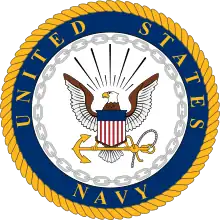Naval Information Warfare Systems Command
The Naval Information Warfare Systems Command (NAVWARSYSCOM), based in San Diego, is one of six SYSCOM Echelon II organizations within the United States Navy and is the Navy's technical authority and acquisition command for C4ISR (Command, Control, Communications, Computers, Intelligence, Surveillance and Reconnaissance), business information technology and space systems. Echelon II means that the organization reports to someone who, in turn, reports directly to the Chief of Naval Operations on the military side. From a civilian perspective, NAVWARSYSCOM reports to the Assistant Secretary of the Navy (RDA).[1] The command was formerly known as SPAWAR, or the Space and Naval Warfare Systems Command and was renamed in June 2019 to better align its identity with its mission.[2]
| Naval Information Warfare Systems Command (NAVWARSYSCOM) | |
|---|---|
 | |
| Allegiance | |
| Branch | |
| Part of | SYSCOM |
| Garrison/HQ | San Diego, California, U.S. |
| Commanders | |
| Commander | RADM Douglas Small, USN |
| Executive Director | John Pope |
| Command Master Chief | MCPO Thormod Forsted, USN |
NAVWARSYSCOM supports over 150 programs managed by the Program Executive Office (PEO) for Command, Control, Communications, Computers and Intelligence (C4I), as well as the programs of PEO for Enterprise Information Systems (PEO EIS) and PEO Space Systems. These PEOs are located in the greater Washington, D.C. area. The Naval Information Warfare Center (NIWC) Atlantic is located in Charleston, SC, and also includes facilities in Norfolk, VA, New Orleans and Stuttgart, Germany. NIWC Pacific is located in San Diego, and includes facilities in Japan, Guam and Hawaii. Effective February 18, 2019, the names of the systems centers changed to Naval Information Warfare Center Atlantic and Pacific.[3][4]
History
A number of mergers over the years have led to the current organization. Eighty percent of the Point Loma Military Reservation evolved into the Naval Electronics Laboratory Center (NELC) at the end of World War II. In the 1960s, NELC was tasked with 4C: Command, Control, Communications and Computers. In 1977 NELC was merged into the Naval Ocean Systems Center (NOSC) and eventually was merged into SPAWAR (now NAVWAR).
The Naval Command, Control and Ocean Surveillance Center (NCCOSC) was SPAWAR's warfare center for command, control, communications, and ocean surveillance. NCCOSC's mission, as part of SPAWAR, was to develop, acquire, and support systems for information transfer and management to provide U.S. naval forces a decisive warfare advantage, and to be the Navy's center for research, development, test and evaluation, engineering, and fleet support for command, control, communications, and ocean surveillance systems.
In June 2019, the Space and Naval Warfare Systems Command was renamed the Naval Information Warfare Systems Command.[5]
Responsibilities
_Headquarters_in_San_Diego.jpg.webp)
NAVWARSYSCOM designs and develops communications and information systems. They employ over 12,000 professionals located around the world and close to the United States Navy fleet.
NAVWARSYSCOM is responsible for managing Air Traffic Control contractors in Afghanistan, including the Kabul en route air traffic control center, the Kabul, Kandahar, and Bagram approach control radar facilities, and respective control towers.
NAVWARSYSCOM provides systems engineering and technical support for the development and maintenance of C4ISR (command, control, communications, computers, intelligence, surveillance and reconnaissance), business information technology and space capabilities. These are used in ships, aircraft and vehicles to connect individual platforms into integrated systems for the purpose of information sharing among Navy, Marine, joint forces, federal agencies and international allies.
- Command and Control: to organize, direct, coordinate, deploy and control forces to accomplish assigned missions
- Responsible for managing Air Traffic Control contractors in the Afghanistan theater of operations. Includes the Kabul en route air traffic control center, Kabul, Kandahar, and Bagram approach control radar facilities, as well as control towers at all three locations.
- Intelligence, Surveillance, Reconnaissance and Information Operations: to collect, process, exploit and disseminate information regarding an adversary's capability and intent
- Cyberspace Operations: to operate and protect communications and networks, while exploiting and disrupting adversary's command and control
- Business Information Technology (IT) and Enterprise Information Systems: to enable business processes and to ensure standard IT capabilities
- Enterprise Systems Engineering: to develop solutions based on capability needs, design considerations and constraints
- Space Systems: to procure and manage narrowband communication satellites in support of the Department of Defense and other government agencies
- Communications and Networks: to provide information through voice, video and data
Program Executive Offices (PEO)
NAVWAR's three affiliated Program Executive Offices (PEOs) are responsible for the prototyping, procurement, and fielding of C4ISR (Command, Control, Communications, Computers, Intelligence, Surveillance and Reconnaissance), business information technology and space systems. Their mission is to develop, acquire, field and sustain affordable and integrated state of the art equipment for the Navy.
PEOs report to the NAVWAR commander for planning and execution of in-service support, and to the Assistant Secretary of the Navy (Research, Development and Acquisition) for acquisition-related matters.[6]
The NAVWAR-affiliated PEOs are:
See also
References
- "Naval Information Warfare Command Organization". NAVWAR. Retrieved 29 October 2020.
- "Naval Information Warfare Center Atlantic" (PDF). NIWC Atlantic. 1 October 2020. p. 4. Retrieved 23 October 2020.
- Fuentes, Gidget (February 13, 2019). "WEST: SPAWAR Systems Centers Rebranded as Naval Information Warfare Centers". U.S. Naval Institute. Retrieved 14 February 2019.
- "Naval Information Warfare Center Atlantic" (PDF). NIWC Atlantic. 1 October 2020. p. 4. Retrieved 23 October 2020.
- "Naval Information Warfare Center Atlantic" (PDF). NIWC Atlantic. 1 October 2020. p. 4. Retrieved 23 October 2020.
- "Naval Information Warfare Systems Command (NAVWAR) Competencies". NAVWAR. Retrieved 29 October 2020.
- "Program Executive Office Command, Control, Communications, Computers and Intelligence (PEO C4I) and Space Systems". Naval Information Warfare Systems Command. Retrieved 29 October 2020.
- "Program Executive Office for Digital and Enterprise Services (PEO Digital)". Naval Information Warfare Systems Command. Retrieved 29 October 2020.
- "Program Executive Office Manpower, Logistics and Business Solutions". Naval Information Warfare Systems Command. Retrieved 29 October 2020.
External links
| Wikimedia Commons has media related to Space and Naval Warfare Systems Command. |
